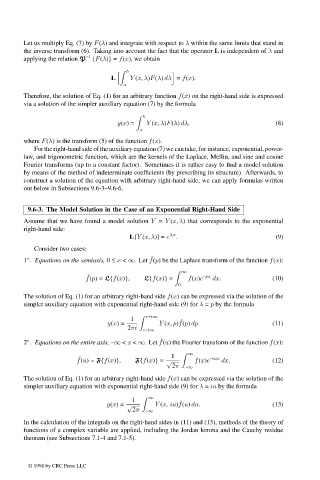Page 498 - Handbook Of Integral Equations
P. 498
Let us multiply Eq. (7) by F(λ) and integrate with respect to λ within the same limits that stand in
the inverse transform (6). Taking into account the fact that the operator L is independent of λ and
–1
applying the relation P {F(λ)} = f(x), we obtain
b
L Y (x, λ)F(λ) dλ = f(x).
a
Therefore, the solution of Eq. (1) for an arbitrary function f(x) on the right-hand side is expressed
via a solution of the simpler auxiliary equation (7) by the formula
b
y(x)= Y (x, λ)F(λ) dλ, (8)
a
where F(λ) is the transform (5) of the function f(x).
For the right-hand side of the auxiliary equation (7) we can take, for instance, exponential, power-
law, and trigonometric function, which are the kernels of the Laplace, Mellin, and sine and cosine
Fourier transforms (up to a constant factor). Sometimes it is rather easy to find a model solution
by means of the method of indeterminate coefficients (by prescribing its structure). Afterwards, to
construct a solution of the equation with arbitrary right-hand side, we can apply formulas written
out below in Subsections 9.6-3–9.6-6.
9.6-3. The Model Solution in the Case of an Exponential Right-Hand Side
Assume that we have found a model solution Y = Y (x, λ) that corresponds to the exponential
right-hand side:
λx
L [Y (x, λ)] = e . (9)
Consider two cases:
˜
◦
1 . Equations on the semiaxis, 0 ≤ x < ∞. Let f(p) be the Laplace transform of the function f(x):
∞
˜
f(p)= L{f(x)}, L{f(x)}≡ f(x)e –px dx. (10)
0
The solution of Eq. (1) for an arbitrary right-hand side f(x) can be expressed via the solution of the
simpler auxiliary equation with exponential right-hand side (9) for λ = p by the formula
1 c+i∞
˜
y(x)= Y (x, p)f(p) dp. (11)
2πi
c–i∞
˜
◦
2 . Equations on the entire axis, –∞ < x < ∞. Let f(u) the Fourier transform of the function f(x):
1 ∞ –iux
˜
f(u)= F{f(x)}, F{f(x)}≡ √ f(x)e dx. (12)
2π –∞
The solution of Eq. (1) for an arbitrary right-hand side f(x) can be expressed via the solution of the
simpler auxiliary equation with exponential right-hand side (9) for λ = iu by the formula
1 ∞
˜
y(x)= √ Y (x, iu)f(u) du. (13)
2π –∞
In the calculation of the integrals on the right-hand sides in (11) and (13), methods of the theory of
functions of a complex variable are applied, including the Jordan lemma and the Cauchy residue
theorem (see Subsections 7.1-4 and 7.1-5).
© 1998 by CRC Press LLC
© 1998 by CRC Press LLC
Page 480

